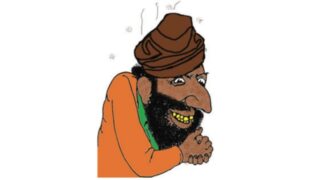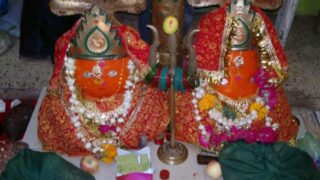The legendary Indian sect of stranglers probably existed, although controversies are not settled—but using them to slander Hinduism does not make sense.
by Massimo Introvigne


India, 1830. A caravan travels the roads and jungles of the immense Indian subcontinent. It meets another caravan of friendly merchants. The two groups decide to travel together. The travelers of the first caravan enjoy the trip: the merchants are cheerful, full of life, play music, share drinks. and know how to tell traditional Indian stories in a lively way. After a few days, suddenly, a signal is heard. The alleged merchants throw the travelers off their horses. With consummate skill, some immobilize the travelers by holding them by the feet and hands, so that others can pass a noose around their necks and strangle them.
The entire drama was consummated in a matter of minutes. The nice merchants, in reality, were not merchants at all but Thugs, followers of a feared “cult” of jungle stranglers. Italians know the Thugs if they have read the novels of Emilio Salgari (1862–1911), something all Italian teenagers used to do until a few years ago, before the Internet took over. His The Mysteries of the Black Jungle also had several movie and TV versions.


In Britain, Thugs may show up in sensational family stories passed to new generations by a great-grandfather who was an officer in India. The word “thug” has passed into the English language to mean a street bandit. Americans, whose myths may be more recent, saw the Thugs in the movie Indiana Jones and the Temple of Doom, which also originated a role-playing game centered on the stranglers’ organization, the Thuggee.
But did Thugs really exist? Sometimes, the Thuggee has been used to slander Hinduism, or even religion in general. In 1830, William Sleeman (1788–1856) converted the Thugs into a national issue in British India with a letter he wrote to the Calcutta Literary Gazette. Journal of Belles Lettres, Sciences and the Arts, which was widely reprinted.
Even more sensational was the book Confessions of a Thug, published in 1839 by British official Meadows Taylor (1808–1876) by novelizing the confessions of different men arrested as Thugs by the colonial authorities in 1832. Happily, there are today better scholarly sources, such as Martine van Woerkens’ 2002 book, originally published in French and translated by University of Chicago Press, The Strangled Traveler: Colonial Imaginings and the Thugs of India.


This and other studies may help us addressing three questions: did the Thugs really exist? If yes, does something of them remain in today’s India? If yes, again, were they a religious “cult” or a simple criminal association? Not surprisingly, the first question is the most hotly debated. Some contemporary Indian and Western colonial studies scholars argue that Thugs are an invention of British colonialism, an archetype of the “inferior” and violent Indian built by William Sleeman, who both organized the repression of the Thugs and popularized their history in the West. According to this version, Sleeman generalized occasional episodes of crime, and sometimes executed innocent men on the basis of simple slander.
Van Woerkens believes that this theory is not supported by a dispassionate study of the sources. An examination of the trial records shows that the British repression of the Thugs was indeed harsh, and 3,869 were executed. The cultural distance between judges and accused probably led to some miscarriages of justice. However, van Woerkens concludes that the Thugs not only existed but were responsible for thousands of murders.
Their repression was applauded by ta majority of the Indian population, who did not sympathize with the Thugs, but rather pitied their victims. With all his prejudices, William Sleeman also supplied, together with what we would today call fake news, some real information about the Thugs and their secret language, the Ramasee, rendering a service to historians.


Whatever the Thugs really were, it was because of the popular support that British repression was successful. In the last decades of the 19th century in India there were no more Thugs in the proper sense of the term. This does not exclude the possibility that some groups that have continued to exist up to the present day, even though they are not technically Thugs, retain traits and characteristics partly derived from the reality or myth of the 19th-century stranglers.
Van Woerkens, who published her book in 2002, mentioned deviations in the religious order of the Pandas of Benares. They welcome travelers convinced that dying in Benares may free them from the wheel of reincarnation. However, some were suspected of robbing their “guests,” travelers of the death, and of “helping” them to die faster. These rogue Pandas were sometimes called Thugs, and reportedly used a secret language where some words came from Ramasee. Today, authorities have almost totally eradicated this phenomenon.
Were Thugs part of a religious movement or simply criminals? The answer is not simple, also because the question of the Thugs’ origins is in itself controversial. A Chinese pilgrim, Hiouen Tsang, told of having escaped from stranglers consecrated to Kali already in the 7th century CE, and the name of Thugs is attested at least since the 14th century.
Most scholars think that the Thugs were born as an antinomian and extreme wing of the great movement that goes by the name of Tantrism. They were a radical fringe of a Tantric current that worshiped as its main deity Kali, a mother who nourishes but also punishes and destroys. If we believe the British courts’ accounts (some scholars don’t), Thugs were persuaded to perform a cosmic duty to the benefit of all humans. Without the ritual sacrifice of the few they strangled, Kali might have destroyed humanity as a whole. As for the victims, Thugs claimed they might have helped them to escape the wheel of reincarnation.


Interestingly, Thugs were not all Hindus. There were also Muslim Thugs, and here some historians speculate that a rogue form of Sufism might have led to human sacrifices. Precisely because they were not part of a specific religion, and included both Hindus and Muslims, some scholars have concluded that Thugs were not a sect of Hinduism.
There is no doubt, however, that their origins were religious. Feringhea, a legendary Thug chief who decided to cooperate with the British, stated that lured by the greed of booty, in the 19th century Thugs came to forget their religious motivations and neglected their rituals, losing the protection of the goddess and thus causing their own destruction, of which the British were a mere instrument.
Much of what we know about the Thugs from fictions and movies is false. What we know from British trial transcripts is uncertain. Those who deny that the Thugs ever existed compare these trials to the prosecution of the witches by the Inquisition. However, although tainted by colonial prejudice, British courts in the 19th century did include judges who sincerely tried to ascertain the truth.
Their procedures left detailed records scholars can study today. There were strangled victims, indeed thousands of them, and bodies. It seems unlikely that more than 4,000 cases tried by British courts were simply figments of the colonial police and the judges’ imagination. It seems more probable that Thugs indeed existed, but they were something different from a Hindu sect, and using them to slander Hinduism is both inaccurate and unfair.









